Personal and Professional Development Report for HR Assistant Role
VerifiedAdded on 2020/06/06
|15
|4552
|29
Report
AI Summary
This report delves into personal and professional development, focusing on self-managed learning approaches and their suitability. It evaluates various learning styles, including strategic and meta-learning, and assesses the benefits of self-directed learning for individuals and organizations. The report also analyzes present skills against professional standards, identifying personal and professional development needs, and evaluates opportunities for growth. It includes the creation of a personal and professional development plan, outlining activities to achieve set goals. Furthermore, it critically reflects on the learning process, analyzing work-based problems and applying effective time management strategies. The report emphasizes the importance of continuous learning and the development of skills such as communication, leadership, and problem-solving, while also considering the impact of these skills within the context of an HR assistant role in the British furniture industry.
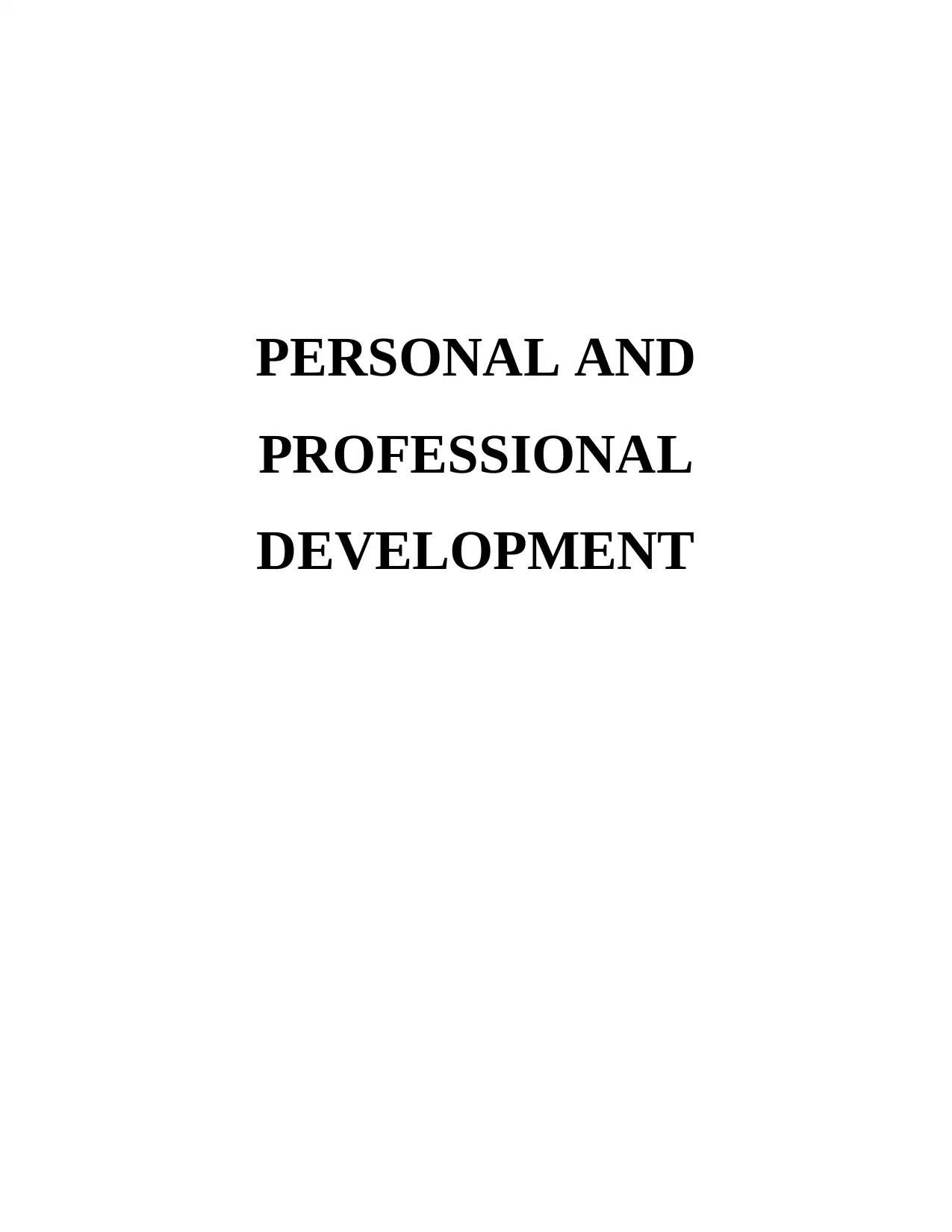
PERSONAL AND
PROFESSIONAL
DEVELOPMENT
PROFESSIONAL
DEVELOPMENT
Paraphrase This Document
Need a fresh take? Get an instant paraphrase of this document with our AI Paraphraser
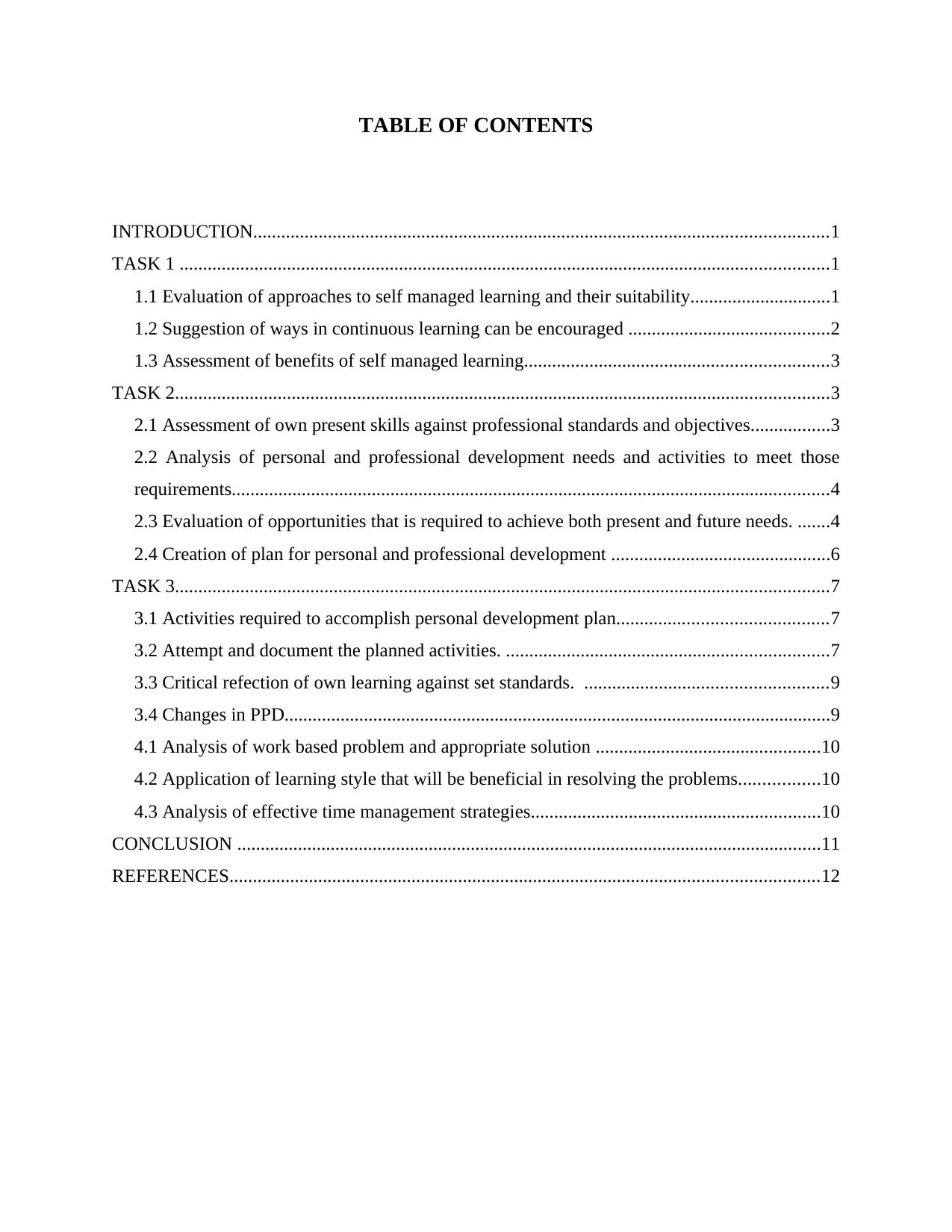
TABLE OF CONTENTS
INTRODUCTION...........................................................................................................................1
TASK 1 ...........................................................................................................................................1
1.1 Evaluation of approaches to self managed learning and their suitability..............................1
1.2 Suggestion of ways in continuous learning can be encouraged ...........................................2
1.3 Assessment of benefits of self managed learning.................................................................3
TASK 2............................................................................................................................................3
2.1 Assessment of own present skills against professional standards and objectives.................3
2.2 Analysis of personal and professional development needs and activities to meet those
requirements................................................................................................................................4
2.3 Evaluation of opportunities that is required to achieve both present and future needs. .......4
2.4 Creation of plan for personal and professional development ...............................................6
TASK 3............................................................................................................................................7
3.1 Activities required to accomplish personal development plan.............................................7
3.2 Attempt and document the planned activities. .....................................................................7
3.3 Critical refection of own learning against set standards. ....................................................9
3.4 Changes in PPD.....................................................................................................................9
4.1 Analysis of work based problem and appropriate solution ................................................10
4.2 Application of learning style that will be beneficial in resolving the problems.................10
4.3 Analysis of effective time management strategies..............................................................10
CONCLUSION .............................................................................................................................11
REFERENCES..............................................................................................................................12
INTRODUCTION...........................................................................................................................1
TASK 1 ...........................................................................................................................................1
1.1 Evaluation of approaches to self managed learning and their suitability..............................1
1.2 Suggestion of ways in continuous learning can be encouraged ...........................................2
1.3 Assessment of benefits of self managed learning.................................................................3
TASK 2............................................................................................................................................3
2.1 Assessment of own present skills against professional standards and objectives.................3
2.2 Analysis of personal and professional development needs and activities to meet those
requirements................................................................................................................................4
2.3 Evaluation of opportunities that is required to achieve both present and future needs. .......4
2.4 Creation of plan for personal and professional development ...............................................6
TASK 3............................................................................................................................................7
3.1 Activities required to accomplish personal development plan.............................................7
3.2 Attempt and document the planned activities. .....................................................................7
3.3 Critical refection of own learning against set standards. ....................................................9
3.4 Changes in PPD.....................................................................................................................9
4.1 Analysis of work based problem and appropriate solution ................................................10
4.2 Application of learning style that will be beneficial in resolving the problems.................10
4.3 Analysis of effective time management strategies..............................................................10
CONCLUSION .............................................................................................................................11
REFERENCES..............................................................................................................................12
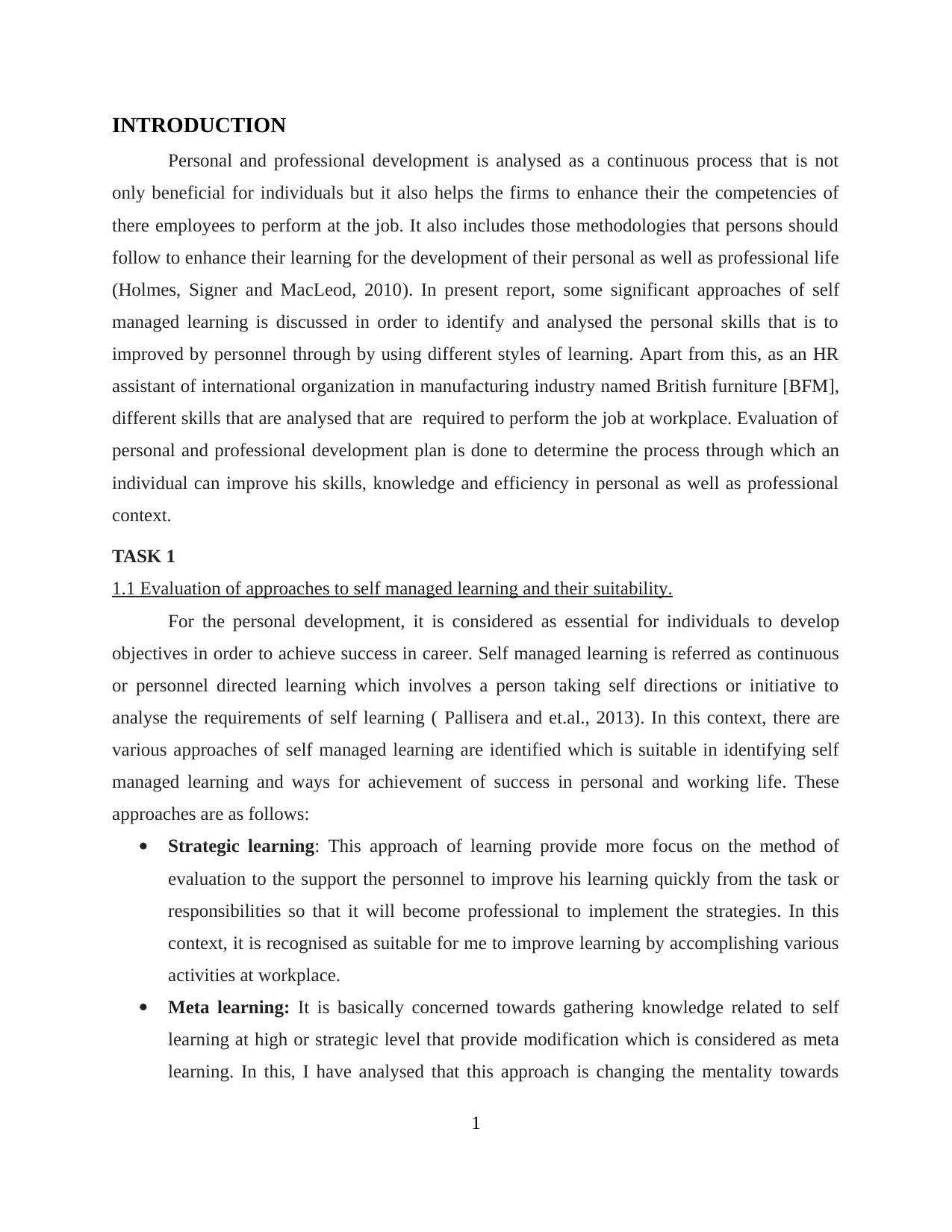
INTRODUCTION
Personal and professional development is analysed as a continuous process that is not
only beneficial for individuals but it also helps the firms to enhance their the competencies of
there employees to perform at the job. It also includes those methodologies that persons should
follow to enhance their learning for the development of their personal as well as professional life
(Holmes, Signer and MacLeod, 2010). In present report, some significant approaches of self
managed learning is discussed in order to identify and analysed the personal skills that is to
improved by personnel through by using different styles of learning. Apart from this, as an HR
assistant of international organization in manufacturing industry named British furniture [BFM],
different skills that are analysed that are required to perform the job at workplace. Evaluation of
personal and professional development plan is done to determine the process through which an
individual can improve his skills, knowledge and efficiency in personal as well as professional
context.
TASK 1
1.1 Evaluation of approaches to self managed learning and their suitability.
For the personal development, it is considered as essential for individuals to develop
objectives in order to achieve success in career. Self managed learning is referred as continuous
or personnel directed learning which involves a person taking self directions or initiative to
analyse the requirements of self learning ( Pallisera and et.al., 2013). In this context, there are
various approaches of self managed learning are identified which is suitable in identifying self
managed learning and ways for achievement of success in personal and working life. These
approaches are as follows:
Strategic learning: This approach of learning provide more focus on the method of
evaluation to the support the personnel to improve his learning quickly from the task or
responsibilities so that it will become professional to implement the strategies. In this
context, it is recognised as suitable for me to improve learning by accomplishing various
activities at workplace.
Meta learning: It is basically concerned towards gathering knowledge related to self
learning at high or strategic level that provide modification which is considered as meta
learning. In this, I have analysed that this approach is changing the mentality towards
1
Personal and professional development is analysed as a continuous process that is not
only beneficial for individuals but it also helps the firms to enhance their the competencies of
there employees to perform at the job. It also includes those methodologies that persons should
follow to enhance their learning for the development of their personal as well as professional life
(Holmes, Signer and MacLeod, 2010). In present report, some significant approaches of self
managed learning is discussed in order to identify and analysed the personal skills that is to
improved by personnel through by using different styles of learning. Apart from this, as an HR
assistant of international organization in manufacturing industry named British furniture [BFM],
different skills that are analysed that are required to perform the job at workplace. Evaluation of
personal and professional development plan is done to determine the process through which an
individual can improve his skills, knowledge and efficiency in personal as well as professional
context.
TASK 1
1.1 Evaluation of approaches to self managed learning and their suitability.
For the personal development, it is considered as essential for individuals to develop
objectives in order to achieve success in career. Self managed learning is referred as continuous
or personnel directed learning which involves a person taking self directions or initiative to
analyse the requirements of self learning ( Pallisera and et.al., 2013). In this context, there are
various approaches of self managed learning are identified which is suitable in identifying self
managed learning and ways for achievement of success in personal and working life. These
approaches are as follows:
Strategic learning: This approach of learning provide more focus on the method of
evaluation to the support the personnel to improve his learning quickly from the task or
responsibilities so that it will become professional to implement the strategies. In this
context, it is recognised as suitable for me to improve learning by accomplishing various
activities at workplace.
Meta learning: It is basically concerned towards gathering knowledge related to self
learning at high or strategic level that provide modification which is considered as meta
learning. In this, I have analysed that this approach is changing the mentality towards
1
⊘ This is a preview!⊘
Do you want full access?
Subscribe today to unlock all pages.

Trusted by 1+ million students worldwide
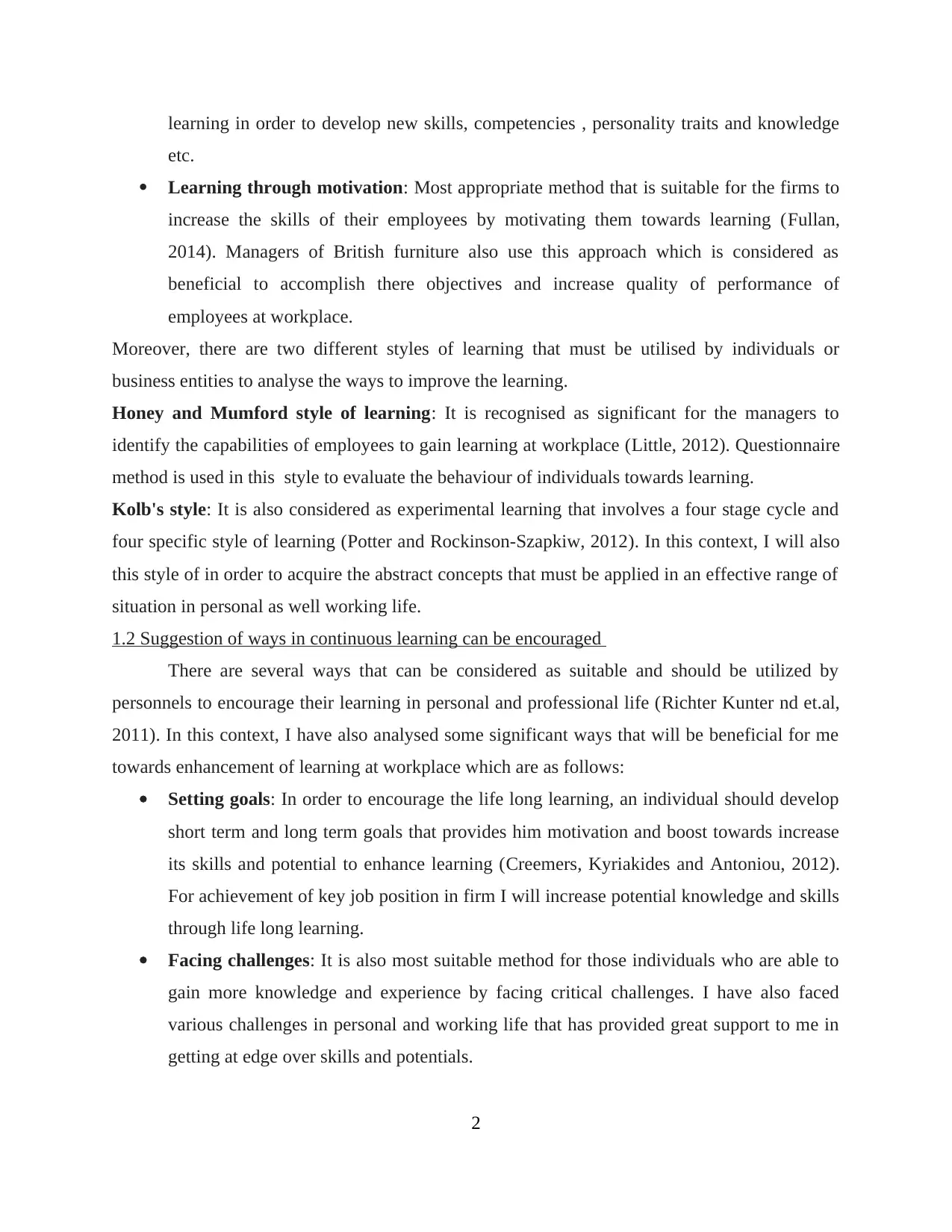
learning in order to develop new skills, competencies , personality traits and knowledge
etc.
Learning through motivation: Most appropriate method that is suitable for the firms to
increase the skills of their employees by motivating them towards learning (Fullan,
2014). Managers of British furniture also use this approach which is considered as
beneficial to accomplish there objectives and increase quality of performance of
employees at workplace.
Moreover, there are two different styles of learning that must be utilised by individuals or
business entities to analyse the ways to improve the learning.
Honey and Mumford style of learning: It is recognised as significant for the managers to
identify the capabilities of employees to gain learning at workplace (Little, 2012). Questionnaire
method is used in this style to evaluate the behaviour of individuals towards learning.
Kolb's style: It is also considered as experimental learning that involves a four stage cycle and
four specific style of learning (Potter and Rockinson‐Szapkiw, 2012). In this context, I will also
this style of in order to acquire the abstract concepts that must be applied in an effective range of
situation in personal as well working life.
1.2 Suggestion of ways in continuous learning can be encouraged
There are several ways that can be considered as suitable and should be utilized by
personnels to encourage their learning in personal and professional life (Richter Kunter nd et.al,
2011). In this context, I have also analysed some significant ways that will be beneficial for me
towards enhancement of learning at workplace which are as follows:
Setting goals: In order to encourage the life long learning, an individual should develop
short term and long term goals that provides him motivation and boost towards increase
its skills and potential to enhance learning (Creemers, Kyriakides and Antoniou, 2012).
For achievement of key job position in firm I will increase potential knowledge and skills
through life long learning.
Facing challenges: It is also most suitable method for those individuals who are able to
gain more knowledge and experience by facing critical challenges. I have also faced
various challenges in personal and working life that has provided great support to me in
getting at edge over skills and potentials.
2
etc.
Learning through motivation: Most appropriate method that is suitable for the firms to
increase the skills of their employees by motivating them towards learning (Fullan,
2014). Managers of British furniture also use this approach which is considered as
beneficial to accomplish there objectives and increase quality of performance of
employees at workplace.
Moreover, there are two different styles of learning that must be utilised by individuals or
business entities to analyse the ways to improve the learning.
Honey and Mumford style of learning: It is recognised as significant for the managers to
identify the capabilities of employees to gain learning at workplace (Little, 2012). Questionnaire
method is used in this style to evaluate the behaviour of individuals towards learning.
Kolb's style: It is also considered as experimental learning that involves a four stage cycle and
four specific style of learning (Potter and Rockinson‐Szapkiw, 2012). In this context, I will also
this style of in order to acquire the abstract concepts that must be applied in an effective range of
situation in personal as well working life.
1.2 Suggestion of ways in continuous learning can be encouraged
There are several ways that can be considered as suitable and should be utilized by
personnels to encourage their learning in personal and professional life (Richter Kunter nd et.al,
2011). In this context, I have also analysed some significant ways that will be beneficial for me
towards enhancement of learning at workplace which are as follows:
Setting goals: In order to encourage the life long learning, an individual should develop
short term and long term goals that provides him motivation and boost towards increase
its skills and potential to enhance learning (Creemers, Kyriakides and Antoniou, 2012).
For achievement of key job position in firm I will increase potential knowledge and skills
through life long learning.
Facing challenges: It is also most suitable method for those individuals who are able to
gain more knowledge and experience by facing critical challenges. I have also faced
various challenges in personal and working life that has provided great support to me in
getting at edge over skills and potentials.
2
Paraphrase This Document
Need a fresh take? Get an instant paraphrase of this document with our AI Paraphraser
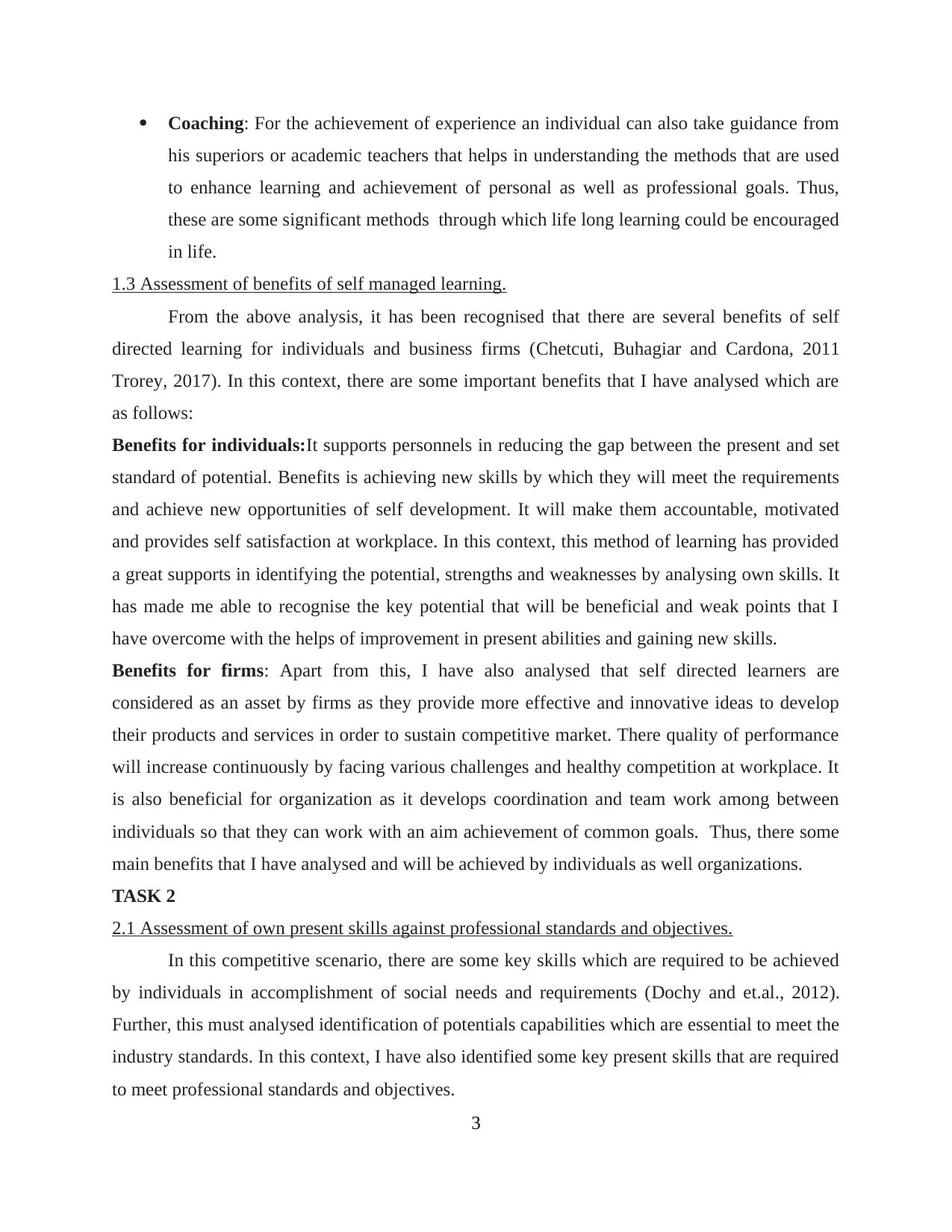
Coaching: For the achievement of experience an individual can also take guidance from
his superiors or academic teachers that helps in understanding the methods that are used
to enhance learning and achievement of personal as well as professional goals. Thus,
these are some significant methods through which life long learning could be encouraged
in life.
1.3 Assessment of benefits of self managed learning.
From the above analysis, it has been recognised that there are several benefits of self
directed learning for individuals and business firms (Chetcuti, Buhagiar and Cardona, 2011
Trorey, 2017). In this context, there are some important benefits that I have analysed which are
as follows:
Benefits for individuals:It supports personnels in reducing the gap between the present and set
standard of potential. Benefits is achieving new skills by which they will meet the requirements
and achieve new opportunities of self development. It will make them accountable, motivated
and provides self satisfaction at workplace. In this context, this method of learning has provided
a great supports in identifying the potential, strengths and weaknesses by analysing own skills. It
has made me able to recognise the key potential that will be beneficial and weak points that I
have overcome with the helps of improvement in present abilities and gaining new skills.
Benefits for firms: Apart from this, I have also analysed that self directed learners are
considered as an asset by firms as they provide more effective and innovative ideas to develop
their products and services in order to sustain competitive market. There quality of performance
will increase continuously by facing various challenges and healthy competition at workplace. It
is also beneficial for organization as it develops coordination and team work among between
individuals so that they can work with an aim achievement of common goals. Thus, there some
main benefits that I have analysed and will be achieved by individuals as well organizations.
TASK 2
2.1 Assessment of own present skills against professional standards and objectives.
In this competitive scenario, there are some key skills which are required to be achieved
by individuals in accomplishment of social needs and requirements (Dochy and et.al., 2012).
Further, this must analysed identification of potentials capabilities which are essential to meet the
industry standards. In this context, I have also identified some key present skills that are required
to meet professional standards and objectives.
3
his superiors or academic teachers that helps in understanding the methods that are used
to enhance learning and achievement of personal as well as professional goals. Thus,
these are some significant methods through which life long learning could be encouraged
in life.
1.3 Assessment of benefits of self managed learning.
From the above analysis, it has been recognised that there are several benefits of self
directed learning for individuals and business firms (Chetcuti, Buhagiar and Cardona, 2011
Trorey, 2017). In this context, there are some important benefits that I have analysed which are
as follows:
Benefits for individuals:It supports personnels in reducing the gap between the present and set
standard of potential. Benefits is achieving new skills by which they will meet the requirements
and achieve new opportunities of self development. It will make them accountable, motivated
and provides self satisfaction at workplace. In this context, this method of learning has provided
a great supports in identifying the potential, strengths and weaknesses by analysing own skills. It
has made me able to recognise the key potential that will be beneficial and weak points that I
have overcome with the helps of improvement in present abilities and gaining new skills.
Benefits for firms: Apart from this, I have also analysed that self directed learners are
considered as an asset by firms as they provide more effective and innovative ideas to develop
their products and services in order to sustain competitive market. There quality of performance
will increase continuously by facing various challenges and healthy competition at workplace. It
is also beneficial for organization as it develops coordination and team work among between
individuals so that they can work with an aim achievement of common goals. Thus, there some
main benefits that I have analysed and will be achieved by individuals as well organizations.
TASK 2
2.1 Assessment of own present skills against professional standards and objectives.
In this competitive scenario, there are some key skills which are required to be achieved
by individuals in accomplishment of social needs and requirements (Dochy and et.al., 2012).
Further, this must analysed identification of potentials capabilities which are essential to meet the
industry standards. In this context, I have also identified some key present skills that are required
to meet professional standards and objectives.
3
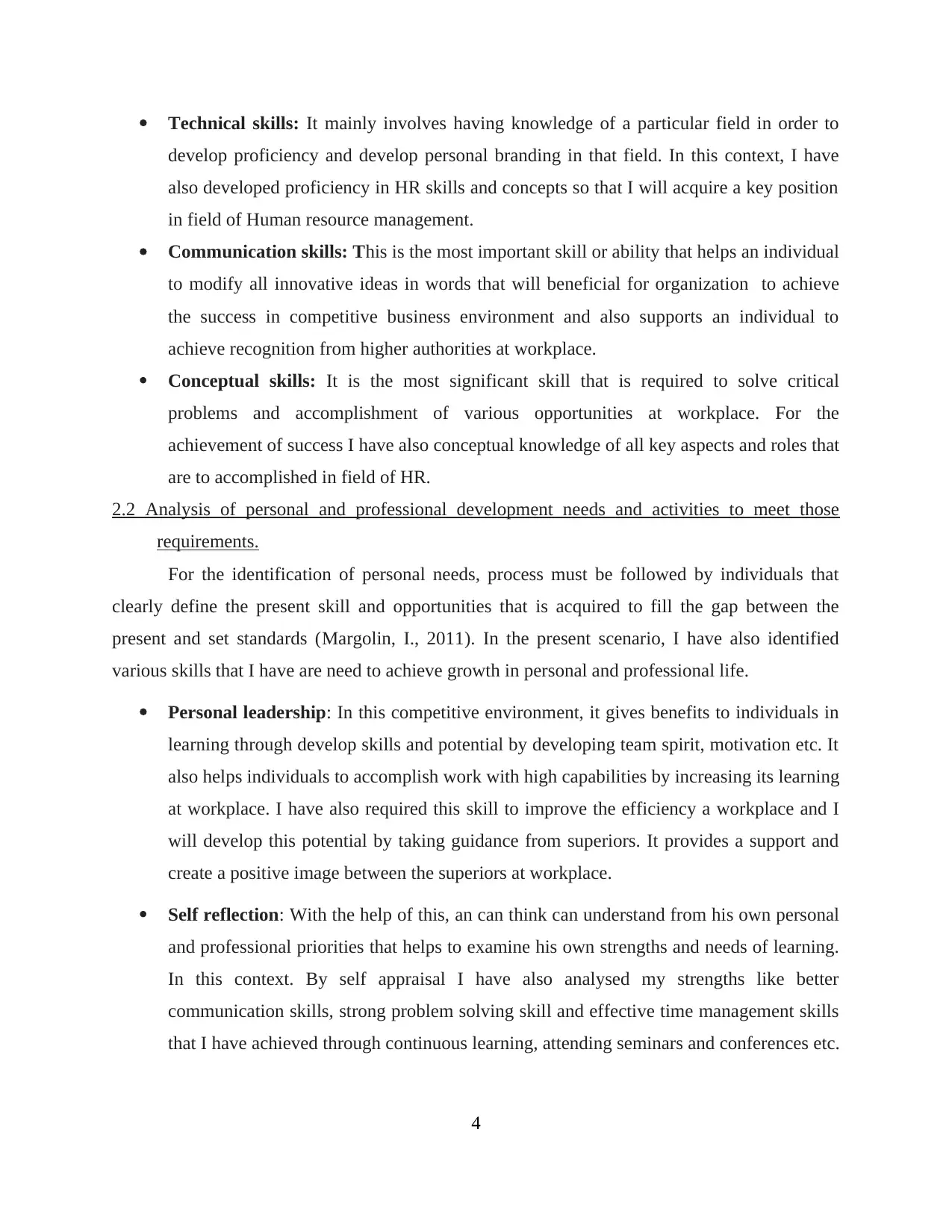
Technical skills: It mainly involves having knowledge of a particular field in order to
develop proficiency and develop personal branding in that field. In this context, I have
also developed proficiency in HR skills and concepts so that I will acquire a key position
in field of Human resource management.
Communication skills: This is the most important skill or ability that helps an individual
to modify all innovative ideas in words that will beneficial for organization to achieve
the success in competitive business environment and also supports an individual to
achieve recognition from higher authorities at workplace.
Conceptual skills: It is the most significant skill that is required to solve critical
problems and accomplishment of various opportunities at workplace. For the
achievement of success I have also conceptual knowledge of all key aspects and roles that
are to accomplished in field of HR.
2.2 Analysis of personal and professional development needs and activities to meet those
requirements.
For the identification of personal needs, process must be followed by individuals that
clearly define the present skill and opportunities that is acquired to fill the gap between the
present and set standards (Margolin, I., 2011). In the present scenario, I have also identified
various skills that I have are need to achieve growth in personal and professional life.
Personal leadership: In this competitive environment, it gives benefits to individuals in
learning through develop skills and potential by developing team spirit, motivation etc. It
also helps individuals to accomplish work with high capabilities by increasing its learning
at workplace. I have also required this skill to improve the efficiency a workplace and I
will develop this potential by taking guidance from superiors. It provides a support and
create a positive image between the superiors at workplace.
Self reflection: With the help of this, an can think can understand from his own personal
and professional priorities that helps to examine his own strengths and needs of learning.
In this context. By self appraisal I have also analysed my strengths like better
communication skills, strong problem solving skill and effective time management skills
that I have achieved through continuous learning, attending seminars and conferences etc.
4
develop proficiency and develop personal branding in that field. In this context, I have
also developed proficiency in HR skills and concepts so that I will acquire a key position
in field of Human resource management.
Communication skills: This is the most important skill or ability that helps an individual
to modify all innovative ideas in words that will beneficial for organization to achieve
the success in competitive business environment and also supports an individual to
achieve recognition from higher authorities at workplace.
Conceptual skills: It is the most significant skill that is required to solve critical
problems and accomplishment of various opportunities at workplace. For the
achievement of success I have also conceptual knowledge of all key aspects and roles that
are to accomplished in field of HR.
2.2 Analysis of personal and professional development needs and activities to meet those
requirements.
For the identification of personal needs, process must be followed by individuals that
clearly define the present skill and opportunities that is acquired to fill the gap between the
present and set standards (Margolin, I., 2011). In the present scenario, I have also identified
various skills that I have are need to achieve growth in personal and professional life.
Personal leadership: In this competitive environment, it gives benefits to individuals in
learning through develop skills and potential by developing team spirit, motivation etc. It
also helps individuals to accomplish work with high capabilities by increasing its learning
at workplace. I have also required this skill to improve the efficiency a workplace and I
will develop this potential by taking guidance from superiors. It provides a support and
create a positive image between the superiors at workplace.
Self reflection: With the help of this, an can think can understand from his own personal
and professional priorities that helps to examine his own strengths and needs of learning.
In this context. By self appraisal I have also analysed my strengths like better
communication skills, strong problem solving skill and effective time management skills
that I have achieved through continuous learning, attending seminars and conferences etc.
4
⊘ This is a preview!⊘
Do you want full access?
Subscribe today to unlock all pages.

Trusted by 1+ million students worldwide

It has provided an understanding of skills that is required in future such as leadership
skill, planning and managing skills etc.
2.3 Evaluation of opportunities that is required to achieve both present and future needs.
Present and future
needs.
Rankings Current competencies Direction to improve.
Leadership skills I have weak leadership
skills as I have faced
various some problems in
guiding co workers within
the organization.
In order to improve this
skill I will observe my
superiors and recognise
there technique
managing and guiding
employees at
workplace.
Communication skill Participation in various
seminars and conferences
has provided a better
understanding of
communicating with the
people.
For the achievement of
key position I will
enhance my skill by
interacting with other
employees and also
read books to gain
knowledge of different
languages.
Time management
skill
I always prepare schedules
and prioritize my work to
make balance between
personal as well as
professional life.
By distribution of time
for every activity I will
effective manage my
learning and working
life in the future.
Problems solving skill Always learn by taking
challenges and solving
Either by taking
superior advice or by
5
skill, planning and managing skills etc.
2.3 Evaluation of opportunities that is required to achieve both present and future needs.
Present and future
needs.
Rankings Current competencies Direction to improve.
Leadership skills I have weak leadership
skills as I have faced
various some problems in
guiding co workers within
the organization.
In order to improve this
skill I will observe my
superiors and recognise
there technique
managing and guiding
employees at
workplace.
Communication skill Participation in various
seminars and conferences
has provided a better
understanding of
communicating with the
people.
For the achievement of
key position I will
enhance my skill by
interacting with other
employees and also
read books to gain
knowledge of different
languages.
Time management
skill
I always prepare schedules
and prioritize my work to
make balance between
personal as well as
professional life.
By distribution of time
for every activity I will
effective manage my
learning and working
life in the future.
Problems solving skill Always learn by taking
challenges and solving
Either by taking
superior advice or by
5
Paraphrase This Document
Need a fresh take? Get an instant paraphrase of this document with our AI Paraphraser
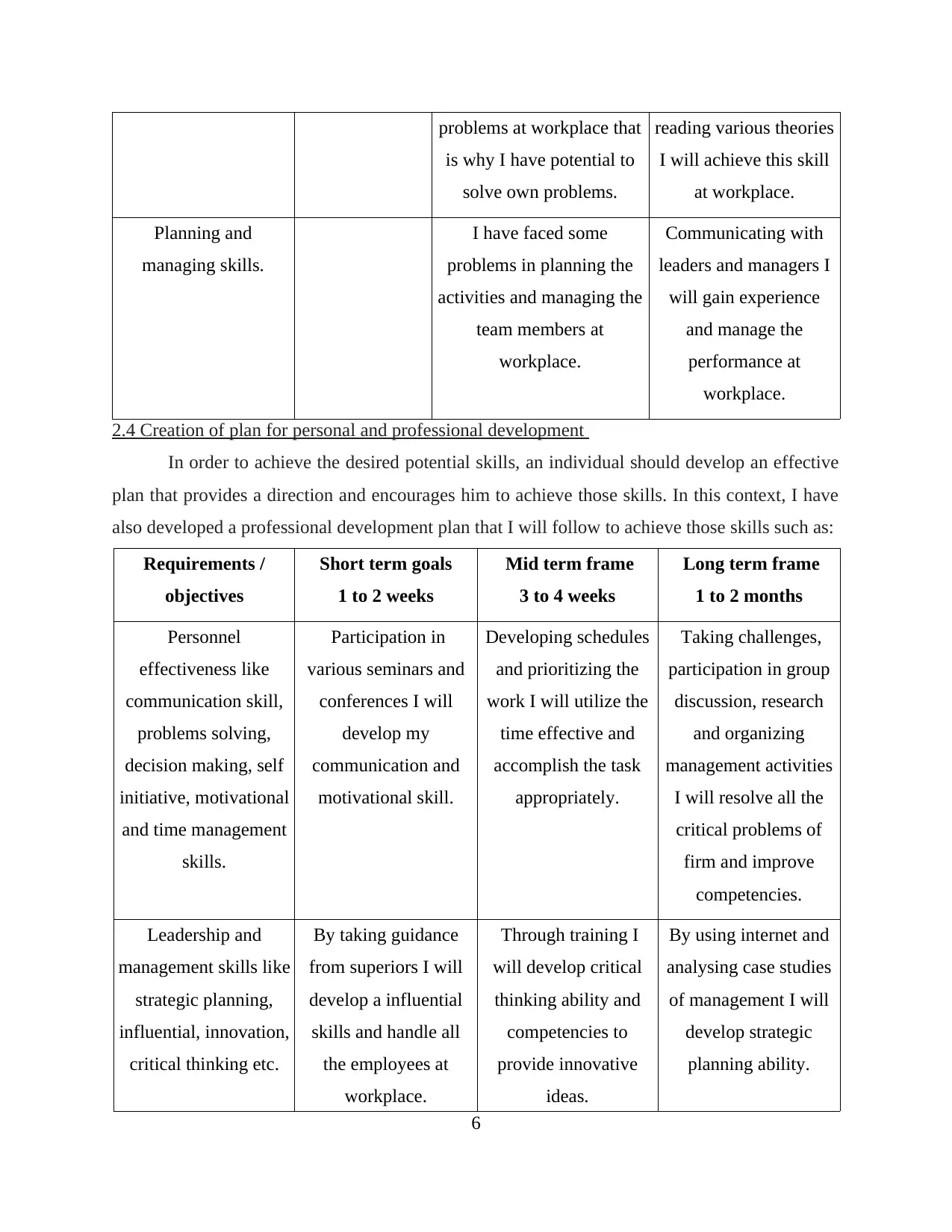
problems at workplace that
is why I have potential to
solve own problems.
reading various theories
I will achieve this skill
at workplace.
Planning and
managing skills.
I have faced some
problems in planning the
activities and managing the
team members at
workplace.
Communicating with
leaders and managers I
will gain experience
and manage the
performance at
workplace.
2.4 Creation of plan for personal and professional development
In order to achieve the desired potential skills, an individual should develop an effective
plan that provides a direction and encourages him to achieve those skills. In this context, I have
also developed a professional development plan that I will follow to achieve those skills such as:
Requirements /
objectives
Short term goals
1 to 2 weeks
Mid term frame
3 to 4 weeks
Long term frame
1 to 2 months
Personnel
effectiveness like
communication skill,
problems solving,
decision making, self
initiative, motivational
and time management
skills.
Participation in
various seminars and
conferences I will
develop my
communication and
motivational skill.
Developing schedules
and prioritizing the
work I will utilize the
time effective and
accomplish the task
appropriately.
Taking challenges,
participation in group
discussion, research
and organizing
management activities
I will resolve all the
critical problems of
firm and improve
competencies.
Leadership and
management skills like
strategic planning,
influential, innovation,
critical thinking etc.
By taking guidance
from superiors I will
develop a influential
skills and handle all
the employees at
workplace.
Through training I
will develop critical
thinking ability and
competencies to
provide innovative
ideas.
By using internet and
analysing case studies
of management I will
develop strategic
planning ability.
6
is why I have potential to
solve own problems.
reading various theories
I will achieve this skill
at workplace.
Planning and
managing skills.
I have faced some
problems in planning the
activities and managing the
team members at
workplace.
Communicating with
leaders and managers I
will gain experience
and manage the
performance at
workplace.
2.4 Creation of plan for personal and professional development
In order to achieve the desired potential skills, an individual should develop an effective
plan that provides a direction and encourages him to achieve those skills. In this context, I have
also developed a professional development plan that I will follow to achieve those skills such as:
Requirements /
objectives
Short term goals
1 to 2 weeks
Mid term frame
3 to 4 weeks
Long term frame
1 to 2 months
Personnel
effectiveness like
communication skill,
problems solving,
decision making, self
initiative, motivational
and time management
skills.
Participation in
various seminars and
conferences I will
develop my
communication and
motivational skill.
Developing schedules
and prioritizing the
work I will utilize the
time effective and
accomplish the task
appropriately.
Taking challenges,
participation in group
discussion, research
and organizing
management activities
I will resolve all the
critical problems of
firm and improve
competencies.
Leadership and
management skills like
strategic planning,
influential, innovation,
critical thinking etc.
By taking guidance
from superiors I will
develop a influential
skills and handle all
the employees at
workplace.
Through training I
will develop critical
thinking ability and
competencies to
provide innovative
ideas.
By using internet and
analysing case studies
of management I will
develop strategic
planning ability.
6
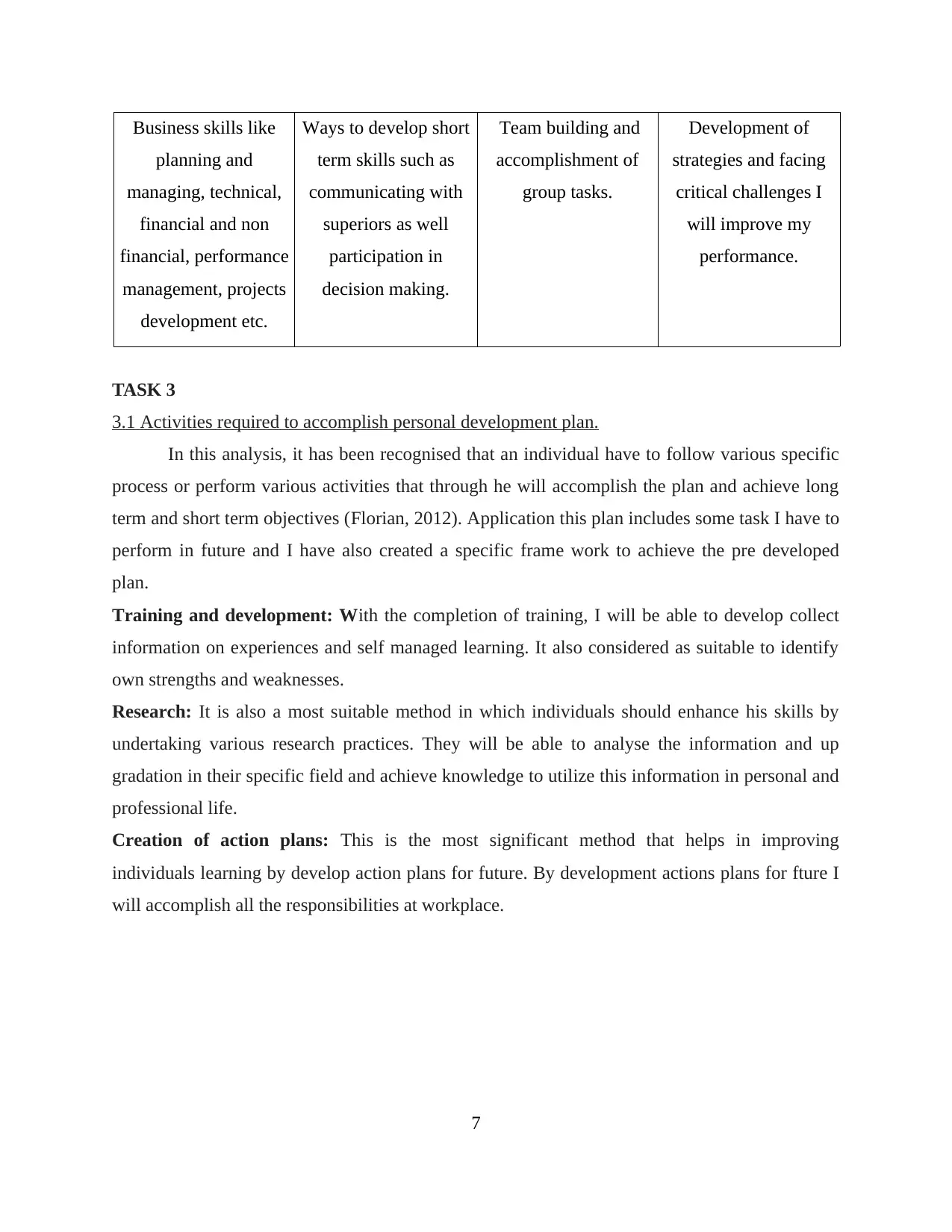
Business skills like
planning and
managing, technical,
financial and non
financial, performance
management, projects
development etc.
Ways to develop short
term skills such as
communicating with
superiors as well
participation in
decision making.
Team building and
accomplishment of
group tasks.
Development of
strategies and facing
critical challenges I
will improve my
performance.
TASK 3
3.1 Activities required to accomplish personal development plan.
In this analysis, it has been recognised that an individual have to follow various specific
process or perform various activities that through he will accomplish the plan and achieve long
term and short term objectives (Florian, 2012). Application this plan includes some task I have to
perform in future and I have also created a specific frame work to achieve the pre developed
plan.
Training and development: With the completion of training, I will be able to develop collect
information on experiences and self managed learning. It also considered as suitable to identify
own strengths and weaknesses.
Research: It is also a most suitable method in which individuals should enhance his skills by
undertaking various research practices. They will be able to analyse the information and up
gradation in their specific field and achieve knowledge to utilize this information in personal and
professional life.
Creation of action plans: This is the most significant method that helps in improving
individuals learning by develop action plans for future. By development actions plans for fture I
will accomplish all the responsibilities at workplace.
7
planning and
managing, technical,
financial and non
financial, performance
management, projects
development etc.
Ways to develop short
term skills such as
communicating with
superiors as well
participation in
decision making.
Team building and
accomplishment of
group tasks.
Development of
strategies and facing
critical challenges I
will improve my
performance.
TASK 3
3.1 Activities required to accomplish personal development plan.
In this analysis, it has been recognised that an individual have to follow various specific
process or perform various activities that through he will accomplish the plan and achieve long
term and short term objectives (Florian, 2012). Application this plan includes some task I have to
perform in future and I have also created a specific frame work to achieve the pre developed
plan.
Training and development: With the completion of training, I will be able to develop collect
information on experiences and self managed learning. It also considered as suitable to identify
own strengths and weaknesses.
Research: It is also a most suitable method in which individuals should enhance his skills by
undertaking various research practices. They will be able to analyse the information and up
gradation in their specific field and achieve knowledge to utilize this information in personal and
professional life.
Creation of action plans: This is the most significant method that helps in improving
individuals learning by develop action plans for future. By development actions plans for fture I
will accomplish all the responsibilities at workplace.
7
⊘ This is a preview!⊘
Do you want full access?
Subscribe today to unlock all pages.

Trusted by 1+ million students worldwide
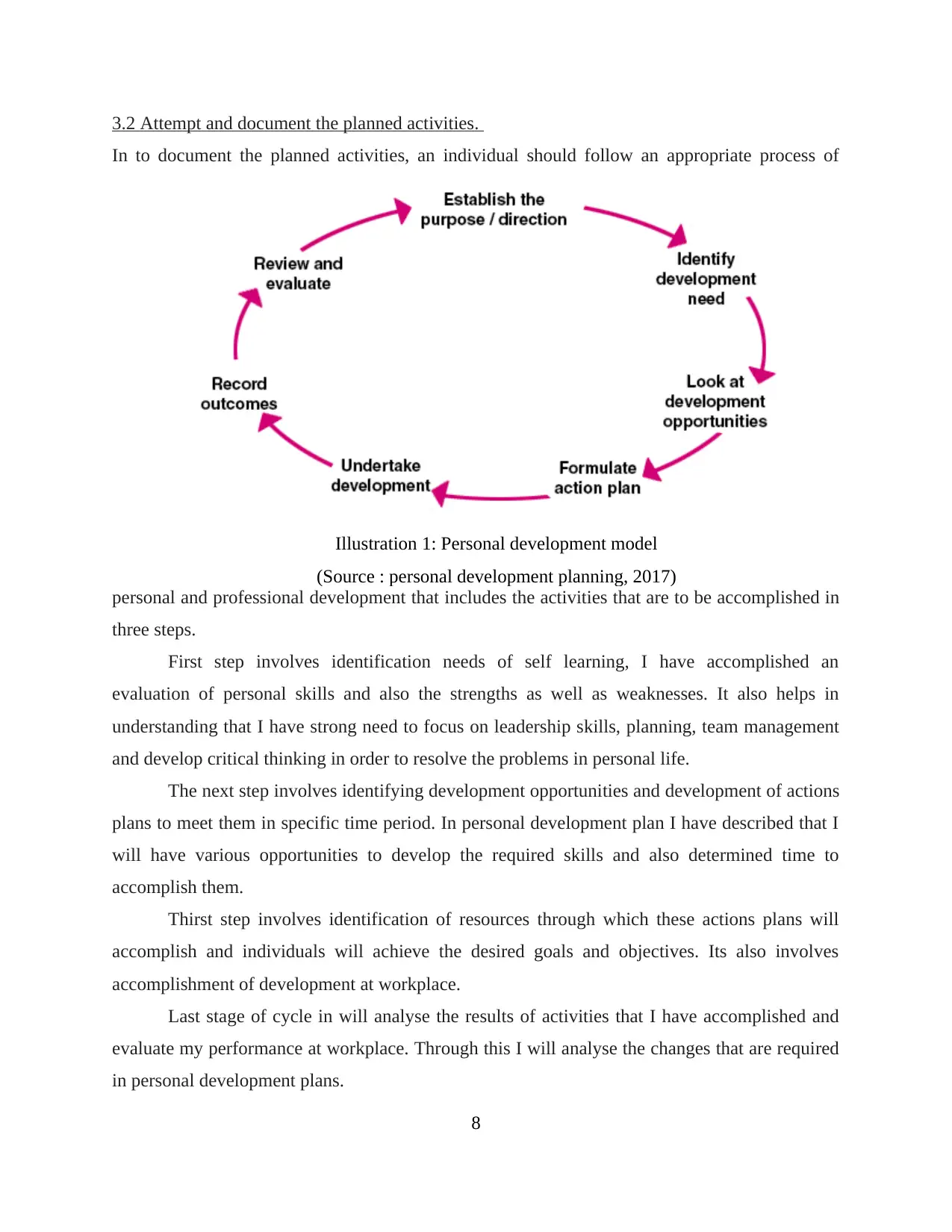
3.2 Attempt and document the planned activities.
In to document the planned activities, an individual should follow an appropriate process of
personal and professional development that includes the activities that are to be accomplished in
three steps.
First step involves identification needs of self learning, I have accomplished an
evaluation of personal skills and also the strengths as well as weaknesses. It also helps in
understanding that I have strong need to focus on leadership skills, planning, team management
and develop critical thinking in order to resolve the problems in personal life.
The next step involves identifying development opportunities and development of actions
plans to meet them in specific time period. In personal development plan I have described that I
will have various opportunities to develop the required skills and also determined time to
accomplish them.
Thirst step involves identification of resources through which these actions plans will
accomplish and individuals will achieve the desired goals and objectives. Its also involves
accomplishment of development at workplace.
Last stage of cycle in will analyse the results of activities that I have accomplished and
evaluate my performance at workplace. Through this I will analyse the changes that are required
in personal development plans.
8
Illustration 1: Personal development model
(Source : personal development planning, 2017)
In to document the planned activities, an individual should follow an appropriate process of
personal and professional development that includes the activities that are to be accomplished in
three steps.
First step involves identification needs of self learning, I have accomplished an
evaluation of personal skills and also the strengths as well as weaknesses. It also helps in
understanding that I have strong need to focus on leadership skills, planning, team management
and develop critical thinking in order to resolve the problems in personal life.
The next step involves identifying development opportunities and development of actions
plans to meet them in specific time period. In personal development plan I have described that I
will have various opportunities to develop the required skills and also determined time to
accomplish them.
Thirst step involves identification of resources through which these actions plans will
accomplish and individuals will achieve the desired goals and objectives. Its also involves
accomplishment of development at workplace.
Last stage of cycle in will analyse the results of activities that I have accomplished and
evaluate my performance at workplace. Through this I will analyse the changes that are required
in personal development plans.
8
Illustration 1: Personal development model
(Source : personal development planning, 2017)
Paraphrase This Document
Need a fresh take? Get an instant paraphrase of this document with our AI Paraphraser
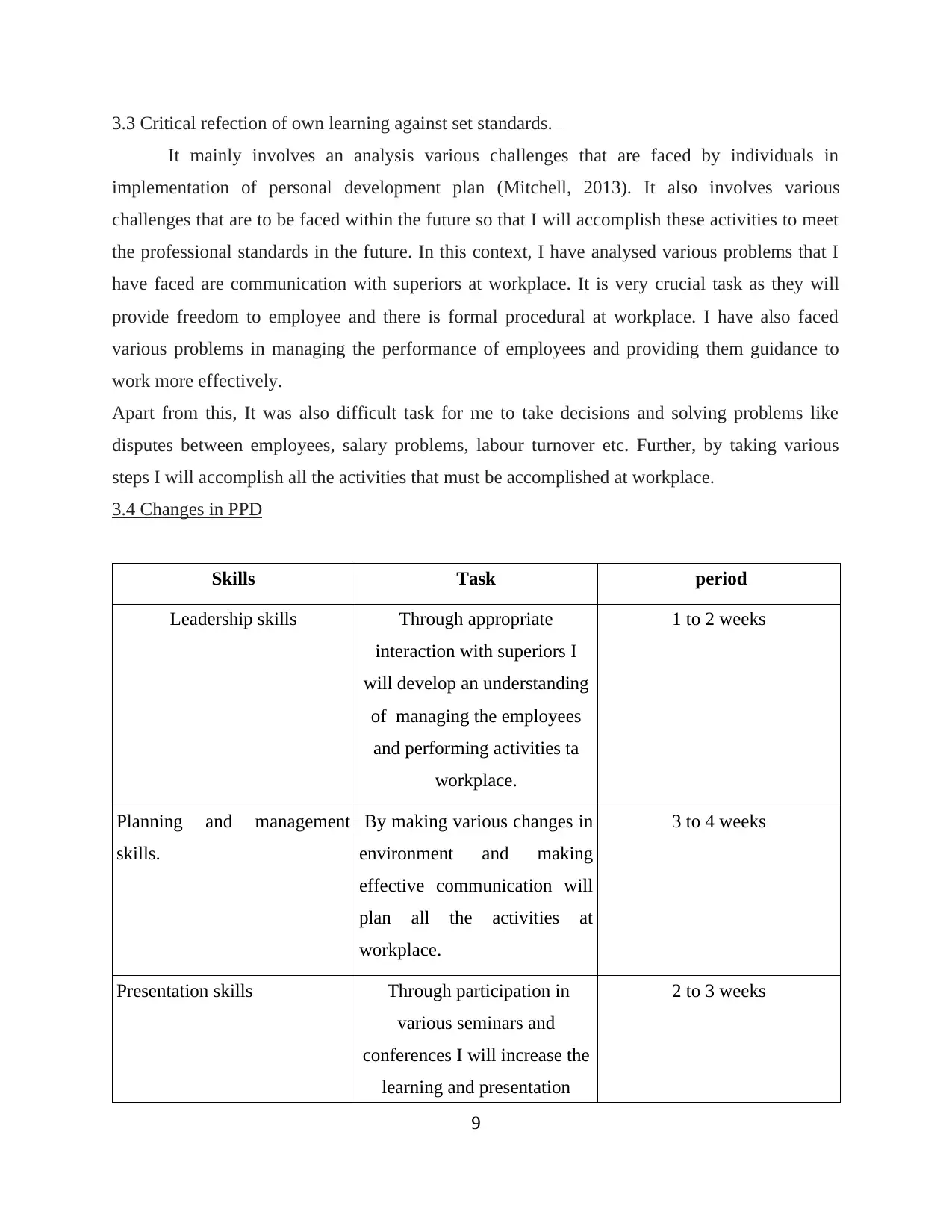
3.3 Critical refection of own learning against set standards.
It mainly involves an analysis various challenges that are faced by individuals in
implementation of personal development plan (Mitchell, 2013). It also involves various
challenges that are to be faced within the future so that I will accomplish these activities to meet
the professional standards in the future. In this context, I have analysed various problems that I
have faced are communication with superiors at workplace. It is very crucial task as they will
provide freedom to employee and there is formal procedural at workplace. I have also faced
various problems in managing the performance of employees and providing them guidance to
work more effectively.
Apart from this, It was also difficult task for me to take decisions and solving problems like
disputes between employees, salary problems, labour turnover etc. Further, by taking various
steps I will accomplish all the activities that must be accomplished at workplace.
3.4 Changes in PPD
Skills Task period
Leadership skills Through appropriate
interaction with superiors I
will develop an understanding
of managing the employees
and performing activities ta
workplace.
1 to 2 weeks
Planning and management
skills.
By making various changes in
environment and making
effective communication will
plan all the activities at
workplace.
3 to 4 weeks
Presentation skills Through participation in
various seminars and
conferences I will increase the
learning and presentation
2 to 3 weeks
9
It mainly involves an analysis various challenges that are faced by individuals in
implementation of personal development plan (Mitchell, 2013). It also involves various
challenges that are to be faced within the future so that I will accomplish these activities to meet
the professional standards in the future. In this context, I have analysed various problems that I
have faced are communication with superiors at workplace. It is very crucial task as they will
provide freedom to employee and there is formal procedural at workplace. I have also faced
various problems in managing the performance of employees and providing them guidance to
work more effectively.
Apart from this, It was also difficult task for me to take decisions and solving problems like
disputes between employees, salary problems, labour turnover etc. Further, by taking various
steps I will accomplish all the activities that must be accomplished at workplace.
3.4 Changes in PPD
Skills Task period
Leadership skills Through appropriate
interaction with superiors I
will develop an understanding
of managing the employees
and performing activities ta
workplace.
1 to 2 weeks
Planning and management
skills.
By making various changes in
environment and making
effective communication will
plan all the activities at
workplace.
3 to 4 weeks
Presentation skills Through participation in
various seminars and
conferences I will increase the
learning and presentation
2 to 3 weeks
9
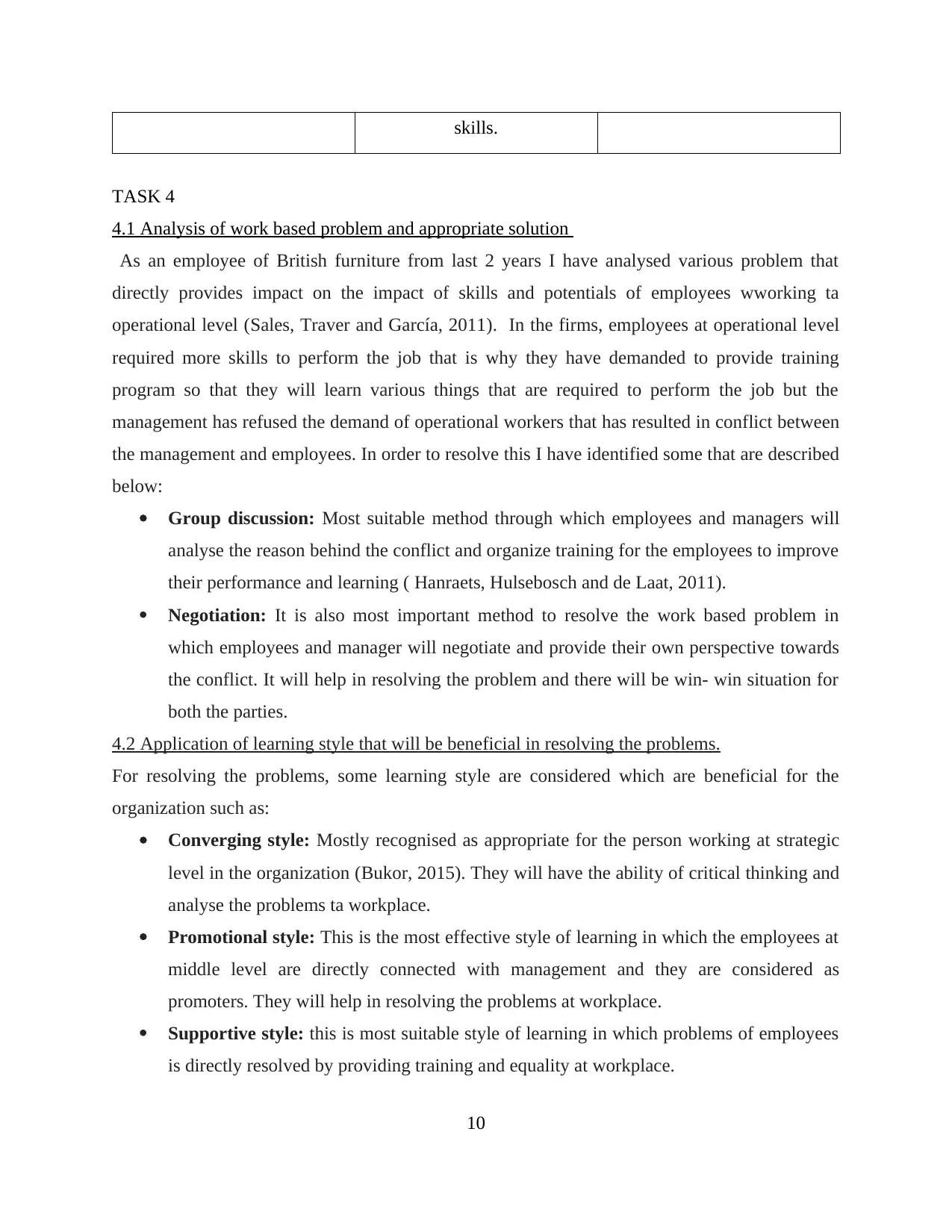
skills.
TASK 4
4.1 Analysis of work based problem and appropriate solution
As an employee of British furniture from last 2 years I have analysed various problem that
directly provides impact on the impact of skills and potentials of employees wworking ta
operational level (Sales, Traver and García, 2011). In the firms, employees at operational level
required more skills to perform the job that is why they have demanded to provide training
program so that they will learn various things that are required to perform the job but the
management has refused the demand of operational workers that has resulted in conflict between
the management and employees. In order to resolve this I have identified some that are described
below:
Group discussion: Most suitable method through which employees and managers will
analyse the reason behind the conflict and organize training for the employees to improve
their performance and learning ( Hanraets, Hulsebosch and de Laat, 2011).
Negotiation: It is also most important method to resolve the work based problem in
which employees and manager will negotiate and provide their own perspective towards
the conflict. It will help in resolving the problem and there will be win- win situation for
both the parties.
4.2 Application of learning style that will be beneficial in resolving the problems.
For resolving the problems, some learning style are considered which are beneficial for the
organization such as:
Converging style: Mostly recognised as appropriate for the person working at strategic
level in the organization (Bukor, 2015). They will have the ability of critical thinking and
analyse the problems ta workplace.
Promotional style: This is the most effective style of learning in which the employees at
middle level are directly connected with management and they are considered as
promoters. They will help in resolving the problems at workplace.
Supportive style: this is most suitable style of learning in which problems of employees
is directly resolved by providing training and equality at workplace.
10
TASK 4
4.1 Analysis of work based problem and appropriate solution
As an employee of British furniture from last 2 years I have analysed various problem that
directly provides impact on the impact of skills and potentials of employees wworking ta
operational level (Sales, Traver and García, 2011). In the firms, employees at operational level
required more skills to perform the job that is why they have demanded to provide training
program so that they will learn various things that are required to perform the job but the
management has refused the demand of operational workers that has resulted in conflict between
the management and employees. In order to resolve this I have identified some that are described
below:
Group discussion: Most suitable method through which employees and managers will
analyse the reason behind the conflict and organize training for the employees to improve
their performance and learning ( Hanraets, Hulsebosch and de Laat, 2011).
Negotiation: It is also most important method to resolve the work based problem in
which employees and manager will negotiate and provide their own perspective towards
the conflict. It will help in resolving the problem and there will be win- win situation for
both the parties.
4.2 Application of learning style that will be beneficial in resolving the problems.
For resolving the problems, some learning style are considered which are beneficial for the
organization such as:
Converging style: Mostly recognised as appropriate for the person working at strategic
level in the organization (Bukor, 2015). They will have the ability of critical thinking and
analyse the problems ta workplace.
Promotional style: This is the most effective style of learning in which the employees at
middle level are directly connected with management and they are considered as
promoters. They will help in resolving the problems at workplace.
Supportive style: this is most suitable style of learning in which problems of employees
is directly resolved by providing training and equality at workplace.
10
⊘ This is a preview!⊘
Do you want full access?
Subscribe today to unlock all pages.

Trusted by 1+ million students worldwide
1 out of 15
Related Documents
Your All-in-One AI-Powered Toolkit for Academic Success.
+13062052269
info@desklib.com
Available 24*7 on WhatsApp / Email
![[object Object]](/_next/static/media/star-bottom.7253800d.svg)
Unlock your academic potential
Copyright © 2020–2025 A2Z Services. All Rights Reserved. Developed and managed by ZUCOL.




